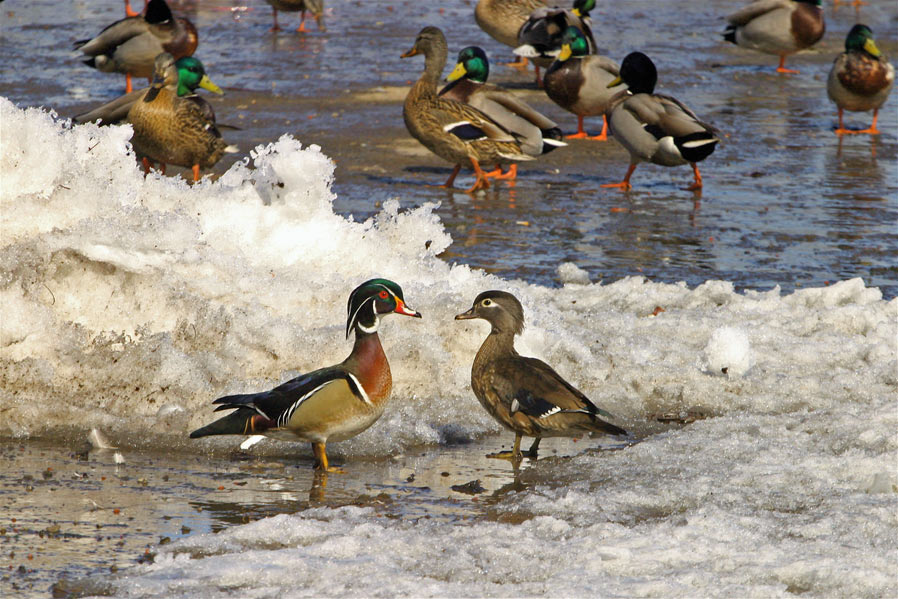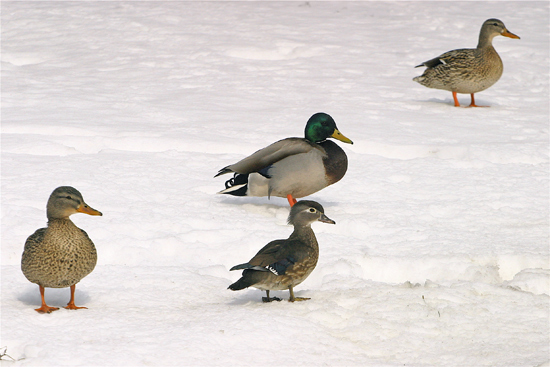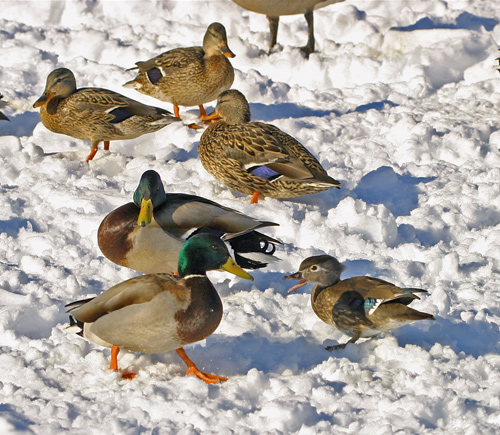- Spring has brought relief and romance for the lonely little wood duck Chilly, right, shown gazing into the eyes of her brightly coloured beau, Woody. © BCP 2010


Warming up to Chilly
One brave little bird toughs it out by herself at Ashbridge’s Bay through harsh Toronto winter
(Story originally published in The Toronto Star, Mar. 31, 2008, p. A10)
That whoop you heard from way down at the lake on Good Friday? That was me, cheering, when I discovered that Chilly’s long, lonely winter was finally over.
But let me back up.
My little feathered friend Chilly is a small, female wood duck — likely a first-year bird — that lived all winter at Ashbridges Bay. Somehow, when the rest of her kin migrated south last fall, she got left behind. She may have been too weak, or perhaps even sick, to make the long annual trek to her species’ overwintering grounds in the southern United States. We’ll never know why she ended up the sole wood duck to stay at the bay. But stay she did, surrounded by flocks of other waterfowl that stayed all year — mallard ducks, ring-billed gulls and Canada geese numbering in the hundreds and hundreds — along with our normal winter ducks — the scaups, long-tails, buffleheads and mergansers.


Chilly is so petite next to the mallards. © BCP 2010
It was only with some pretty powerful binoculars that I discovered Chilly at all, as she spent most of the winter quite far out in the frozen bay, sitting on a boat slip belonging to the Ashbridges Bay Yacht Club. With her pale brown plumage, so similar to the drab female mallards she was always with, she was easy to miss at a distance. But there was something about her that allowed me to single her out. She was much smaller than the mallards, and she had a distinctive white eye ring easily visible with my binoculars.
As the winter wore on, I went down to the bay often, hoping to catch a glimpse of her. I was impressed with her brave struggle to survive the harsh winter. When the temperatures plummeted, the entire flock of mallards left their perching positions on the yacht club piers, and settled in the deep snow of the Ashbridges Bay parking lot. Despite the signs forbidding feeding the birds, countless times I saw people bring bread down to the lake to feed the flocks. The aggressive, shrieking gulls cleaned up, the slower mallards occasionally got a few crusts, but timid Chilly never came close to getting any.


Spunky Chilly defends herself, sassing a much larger male mallard harrassing her. © BCP 2010
There were plenty of dangers for the little bird. Julius, a fellow birder at the bay, told me in February that he had just seen a golden eagle devouring a mallard in a small copse of evergreens near the parking lot. In the same month, I saw a male mallard frozen stiff on a path to the lake. Julius thought he’d been killed by one of the ever-present off-leash dogs in the park.
So every time I saw Chilly toughing it out alone through the near-record snowfall, the howling winds and freezing temperatures, I gave a silent cheer. If she could keep hanging on, she might have the last laugh. If a male showed up in the spring, she’d be able to strut around with a mate considered by many naturalists to be the most beautiful duck in North America. The drake is so flamboyant that the duck’s scientific name, Aix sponsa, means “waterfowl in wedding raiments.”
Earlier this week, I got my wish and Chilly got her mate. A drake, dubbed Woody, has joined the giant flock of mallards at the bay. He stays close by his gal. Whenever Chilly gets more than few feet away, he emits a high-pitched peep peep peep totally unlike the mallards’ loud, harsh quacks. And Chilly, who had never issued a sound except to make a hiss when one of the mallards got too close, now answers back with faint peeps of her own.
Soon the pair will be looking around for just the right tree in which to make their nest and hatch their young. In a few months, there may be some young wood ducks making their fledgling leap from said tree. But it will take some luck. There are plenty of predators around — everything from raccoons, snakes, squirrels to woodpeckers and herons — eager for a chance to devour the ducks’ eggs or hatchlings.
In the meantime, Chilly has her Woody, and all is well in the duck world at the bay.
© BCP 2010


no comments